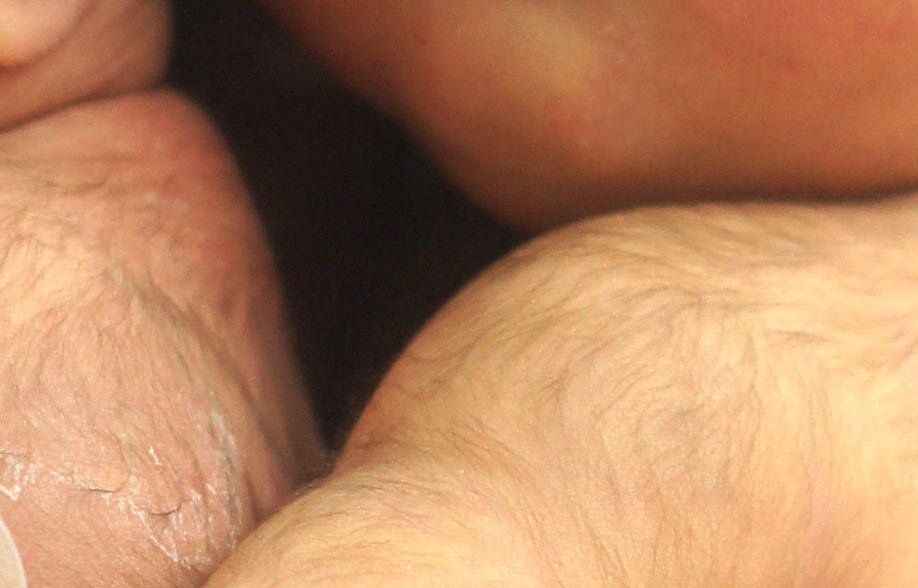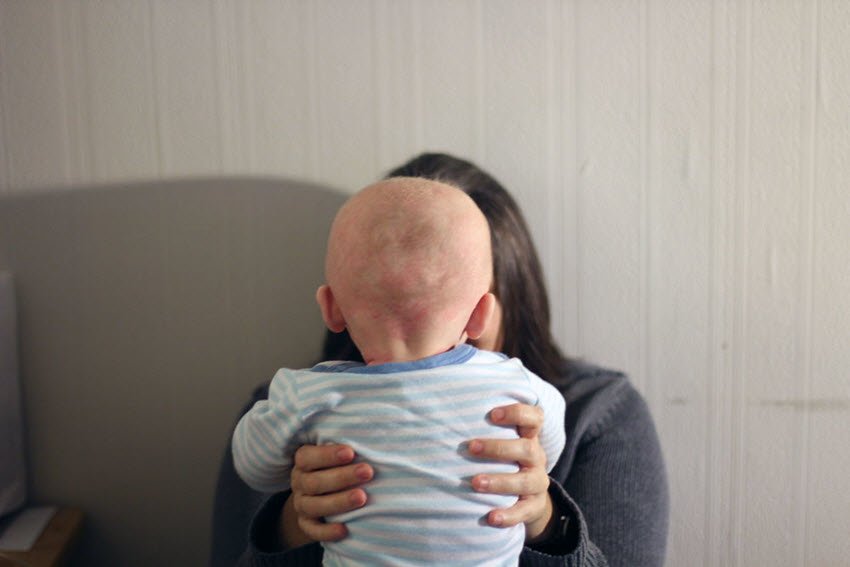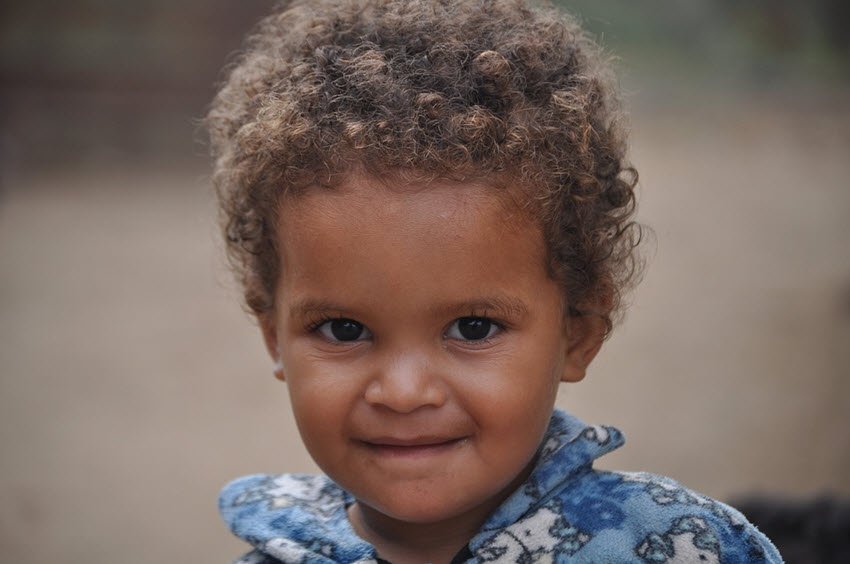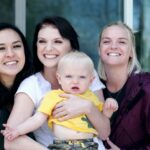Did you know that some babies are born with body hair? This is referred to as lanugo, and it can be a surprise to unsuspecting new parents.
Nevertheless, it’s nothing to panic about. To help get rid of any lingering confusion or stress about lanugo and baby hair in general, I took the liberty of doing some research for you. By the end, you should come away with a better understanding of it all.
Lanugo Hair Meaning
Lanugo is fine hair that can grow in most places on a newborn’s body. It’s soft and usually un-pigmented, but some babies have hair that comes across as white or black.
While your child is developing, lanugo is the first hair that grows out of their hair follicles. Because of that, the hair isn’t found on areas such as their palms, soles of their feet, or their lips.
Produced on your fetus around either the fourth month or fifth month of pregnancy, lanugo protects the vernix caseosa that covers your baby’s skin. It’s that white, greasy substance that may still be on your baby when you deliver them.
This, in turn, protects your baby’s sensitive skin against the amniotic fluid that they’re surrounded by. The lanugo sticks to the vernix, which prevents it from sliding off the skin.
This also helps keep your baby nice and warm. In addition, with the lanugo adhering the vernix caseosa to baby’s skin, they (and you) may have an easier time during delivery as this helps the baby slide through the cervix and birth canal better.
View in gallery
Lanugo Hair on Baby’s Forehead
The forehead is one of the common areas that lanugo will grow on your baby. There’s no particular reasoning behind it as it’s as likely to be found on their forehead as it is on their arms, ears, and shoulders.
This is due to the fact that there are hair follicles found in the forehead. It isn’t anything to worry about since it will naturally fall off over time like the rest of the lanugo.
If you want to speed up the process, you can always slip a soft, newborn-friendly beanie on your baby’s head. Clothes are known to gently pull at the fine hair, easing them off. So, a beanie pulled down low (not covering their eyes!) may help your little one shed those hairs.
Baby Has Hair on Lower Back
Usually, lanugo grows on your baby’s back as well. This tends to cover their back, however, and not just focus on one specific area.
If you do notice just a patch of hair on your baby’s lower back, it may, unfortunately, be a sign of something more serious such as spina bifida occulta.
This indicates a defect underneath the skin, like a small gap in the spine, that isn’t as debilitating as the congenital disability of the spine known as spina bifida.
A small patch of hair on your baby’s lower back is typically the main indicator of spina bifida occulta. Because of this, it’s important to speak with your doctor to determine whether it’s more serious or if the hair is simply lanugo.
View in gallery
My Baby Has Hair on His Privates
If some parents are surprised to notice body hair on their newborns, can you imagine the reaction to finding pubic hair before they’re even a year old?
Shocking, yet true, some babies do develop hair on their private areas. It’s still no need to panic just yet. This can be a sign of some hormonal imbalance.
Or perhaps you’ve heard of the term “precocious puberty“, a condition when a child goes through puberty too early. Not every baby that develops pubic hair is going through that, however, but keep an eye out for additional signs such as a change in their genital size.
Pubic hair isn’t always a sign for concern though. No matter, your best bet is to contact a pediatric endocrinologist, which is a specialist that focuses on hormone-related disorders. This way, you can have a clearer understanding of your baby’s specific case.
Why Does my Baby’s Hair Grow so Slow?
One of the many joys of having a baby is seeing what they’ll look like, and their hair (or lack of) tends to capture the attention first. So, what if you have a baby with relatively little hair or no hair at all, and it doesn’t seem like it’s growing?
Well, there’s no one answer to that as there could be a number of causes. Most of them aren’t anything to worry about, thankfully.
View in gallery
Health Complications
Sometimes, an underlying health issue could be the cause of your baby’s minimal, slow hair growth.
Fungus
Have you noticed your baby’s hair growing in patches? This may be a sign of a fungus like ringworm. It’s easily treated, however, and once your baby’s healthy, you may notice an uptick in their hair growth.
Genetic Disorder
This is typically a rare cause of slower hair growth, but it is possible that the condition is caused by genetics. Take a peek at your own family history, but if there’s nothing to be found, speak with your doctor on getting some tests done.
Any treatment for it will depend on what’s discovered.
Non-Health Causes
In most cases, your baby may simply be slower on the hair growth chart. There may be no big meaning behind it as all babies develop differently because everyone’s different.
Since all babies shed their hair as they grow, maybe you’ve noticed slower hair growth on the back of their heads. In this case, your baby might be laying on their back a bit too much, which can cause more hair to fall out.
Also, take a look at the shampoo you’re using. Be sure that it’s gentle enough for your baby as it may irritate their skin otherwise.
However, if you haven’t noticed any change in your baby’s growth by the time they’ve grown past the one year mark, it doesn’t hurt to bring this up with their pediatrician.
When Does Baby Hair Texture Change?
Hair is something that normally evolves with age. We notice it in ourselves, so it’s no surprise that a baby’s hair texture will also change. When it will occur is different for every baby though.
As I touched on in the previous section, it’s normal for babies to lose their hair in the months after they’re born. When it comes back, the texture can be completely different. This may occur around 12-months-old or 24-months-old.
By the time they reach the toddler years, you may be seeing more of their permanent hair texture come in.
Signs Your Baby Will Have Curly Hair
You won’t know what type of hair your baby will have until their texture stops changing. However, you can check out your family history to get a good idea.
Some babies born to parents where one or both of them have curly hair may have a good chance of coming away with curly hair too. Perhaps someone further down the line has that hair texture like a grandparent.
No matter the case, genetics plays a key role here.
You can also keep an eye out on how your baby’s hair looks when wet and after drying. If you start to notice more curled patterns or even some frizz, those may be signs that their texture is leaning toward curly.
My Baby Has Curly Hair, Will it Stay Curly After a Haircut?
Parents of curly haired children often experience the dread of a haircut as many people claim it’ll cause them to lose those gorgeous curls. However, there doesn’t seem to be any scientific proof backing up that claim.
Let’s start with the basics of curly hair. As I said before, it’s caused by genetics. Curly hair follicles are different than straight hair follicles. Within that, there are several types of curl patterns your baby can have that are unique to them.
As they grow and mature, these patterns naturally change, so a haircut doesn’t have much to do about that. Merely, cutting the hair down might highlight that change.
So, in spite of many parents claiming a haircut cost them their child’s curls, it’s all about the genetics. Some may maintain their baby curls, others may have a different pattern that may seem straighter, while some babies even have curls grow back thicker.
View in gallery
Conclusion
Hair is a fascinating aspect of our bodies that are unique to us starting at the fetus stage in our lives. Babies develop lanugo as an act of protection, and this normal development process falls off in the womb or naturally over time after birth.
When it comes to the hair on our baby’s heads, it can have a life all on its own. There’s no one set development path on hair growth, loss, and texture. Every baby is distinctive, so it’s important to take things one step at a time and keep in contact with your pediatrician if anything seems unusual about their hair.






